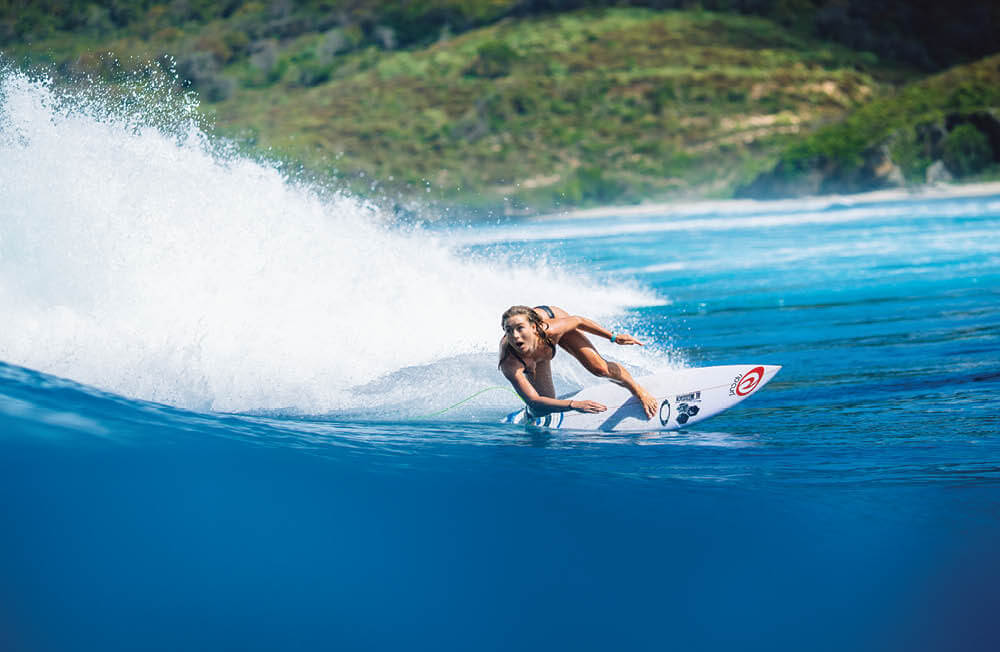What To Expect From Women’s Surfing, Localism and Surfboards In 2018
Share
Did you know SW Editor At Large Sean Doherty has a little stall at the Bangalow markets where he spreads cat hair on an old Spiderman doona then rubs his body in baby oil and rolls on the doona creating a pattern of cat hair which he then reads to predict the future of passers-by? It’s pretty gross. Nevertheless, here are some of those hairy readings as featured in SW 395: The Predictions Issue – out now. Continued from part 1
LOCALISM
The future of localism might depend on how you define the term. The old school local welcome of slashed tyres, dental realignment, and the old Mike Nolan send-off has just about become history. A generation of surfers who’ve travelled the world have made that mindset obsolete, camera phones have made it indictable, and gentrification has neutered previously dangerous beach burbs. But if by “localism” you mean a common sense of stewardship over a local beach, environmental, social, the kind that doesn’t require broken teeth, then you pair it up with daily wave counts and strong surfing chops then you’ve got a fresh mechanism to maintain some kind of social order out in the water.
PRO SURFING
We’ve arrived already at this one. The second the guy pushed the green button at Lemoore back on December 18, 2015, the future of the tour was rewritten. Less than three years later and the wavepool will host its first tour event… and it will be clear almost immediately that it doesn’t belong there. As the only pool event amongst a dozen ocean events, the fundamental differences will be jarring. There’ll be no man-on-man, no lucky waves, runs instead of heats and the judges will score mistakes more than turns. No, the pool doesn’t belong on tour because it belongs on its own tour, and when this happens we’ll see two distinct evolutionary branches of surfing head off in different directions.
WOMEN’S SURFING
The future of women’s surfing is the future of surfing itself, and therein lies our salvation. Apart from a grey army of negatively geared old geezers, every other surfing demographic is currently plateauing with one exception. Teenage girls. And when those teenage girls are no longer teenage girls, and instead of paddling out alone begin paddling out in groups of two, three, six and surfing their local points with the sublime command of Steph Gilmore, a tipping point will be reached. The lineup will be changed forever, the dynamic in the water will shift, and as the placard goes, trust me, I would not want to be the guy out there who has pissed off all these women. On that day, when the women finally wrest full control of surfing from the men, I will throw myself on the floor in front of Queen Sabre, clutching a tattered copy of this magazine, pointing pathetically to this very paragraph, and start begging for a set wave.
NEW SURFBOARDS
There is a silent acknowledgement here that the performance surfboard has, some time ago, reached an ideal natural form and all performance surfboards exist within a 10 per cent dimensional margin of each other. That being the case, then where does the next big shift in surfboards come? Materials, for one. We’re a decade into the performance materials arms race without a clear winner, and the sustainable surfboard remains a lofty ideal for a time when board shapers aren’t scrapping for survival. The other change that lies over the horizon, will, unsurprisingly, happen in the pool. A totally predictable wave face will finally allow the considered development of the surfing snowboard.
OLD SURFBOARDS
Surfing The Pass in Byron fairly regularly over summer has, as always, been an exercise in peering back into time. Pretty much every board in the lineup has some ancestral lineage from the ‘60s or ‘70s – if not indeed actually from the ‘60s or ‘70s – and how this movement will evolve/devolve in decades to come will prove interesting. What started out as a functionality response to twitchy, wafer-thin shortboards that everyone rode but nobody could ride, in time became a statement against Big Surfing. Every wave ridden was a subtle protest against conformity and the corpos, but over time the performance limitations of these old boards began to melt away and some of the best lines were being drawn on them. Al Knost and Torren Martyn as Exhibits A and B, your honour. A Yin-Yang balance has developed between this movement and the leading edge of modern surfing. Whenever surfing has pushed hard at the future – as it’s doing right now – the classic movement has kept it in balance. This balance is here to stay. – Sean Doherty
[shopify embed_type=”product” shop=”coastalwatch-book-shop.myshopify.com” product_handle=”new-surfing-world-issue-395″ show=”all”]








